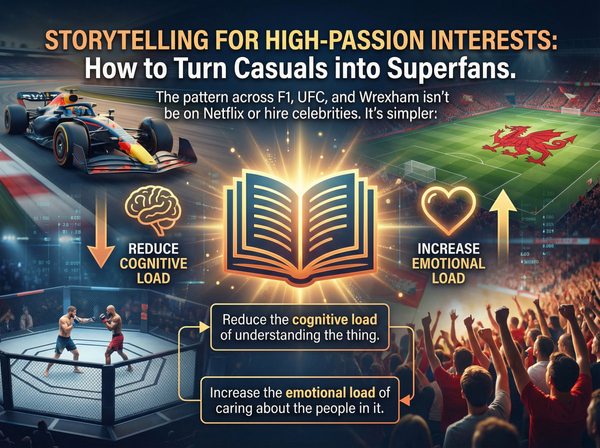The Unbeatable Power of Storytelling in Sales
It's easy to get caught up in the technical specifications, the impressive statistics, and the endless list of features. We create presentations packed with data, hoping to impress potential clients with the sheer brilliance of our product or service.
But often, we miss the most powerful tool in our arsenal: the story.
Think about it. When was the last time a data sheet truly resonated with you? More likely, it was a compelling anecdote, a relatable experience, or a vision vividly painted with words that truly stuck. That's the magic of narrative.
Why Stories Trump Statistics (Almost Every Time)
Our brains are hardwired for stories. From ancient campfire tales to modern blockbusters, narratives are how we make sense of the world, process information, and connect emotionally. In sales, this translates into several critical advantages:
- Simplifying Complexity: You're selling a sophisticated SaaS platform? A complex financial solution? Drowning your prospect in jargon and intricate diagrams will only lead to glazed eyes and confusion. A well-crafted story can take that complexity and distil it into something incredibly simple and digestible, focusing on the impact rather than just the mechanics.
- Creating Relevance: People don't buy products; they buy solutions to their problems. They buy better versions of themselves or their businesses. A story allows you to bridge the gap between your offering and their specific pain points. It makes the abstract tangible and relatable, showing them how your solution applies directly to their world.
- Building Emotional Connection: While logic helps justify a purchase, emotion often drives it. A compelling narrative can tap into a prospect's aspirations, fears, or desires, creating a deeper, more personal connection to your solution. It's no longer just a transaction; it's a journey they can envision themselves on.
- Enhancing Memory: Features fade, but stories stick. Our brains are much better at recalling information presented in a narrative format. When your prospect leaves the meeting, they might forget the exact ROI percentage, but they'll remember the story of how your solution transformed a similar company's operations.
Crafting Your Sales Narrative: Making It Simple, Clear, and Relevant
So, how do you weave this storytelling magic into your sales approach?
1. Know Your Audience (Inside and Out)
This is the bedrock of relevant storytelling. Before you utter a single word, immerse yourself in your prospect's world:
- What are their biggest challenges? Not just generic ones, but their specific, nuanced problems.
- What are their aspirations and goals?
- What industry are they in? What are the trends, pressures, and jargon specific to their sector?
- Who are you talking to? A CEO will care about strategic impact; a Head of Operations about efficiency; a marketing manager about customer acquisition. Tailor your story to their role and concerns.
2. Embrace the "Hero's Journey" (with your client as the hero)
The classic storytelling arc works wonders:
- The Status Quo/Problem: Start by describing a situation that your prospect can relate to – a common challenge or frustration in their industry or role. "Many businesses struggle with siloed data leading to delayed decision-making..."
- The Inciting Incident/Struggle: Show how this problem escalates or creates pain. "...which often results in missed opportunities and escalating costs."
- The Guide/Your Solution: This is where you come in. You're not the hero; you're the wise mentor or the powerful tool that helps the hero (your client) overcome their challenge. "That's where our integrated analytics platform steps in, providing a unified view of all your operational data."
- The Transformation/Resolution: Vividly describe the positive outcome. Paint a picture of what their world looks like after adopting your solution. "Imagine having real-time insights at your fingertips, allowing your teams to make proactive decisions and achieve a 20% increase in operational efficiency, just like [Client X] did."
3. Focus on "Before & After"
This is a powerful storytelling technique. Instead of just describing what your product does, describe the state of the client before your solution and the amazing state after they've implemented it. Use concrete, relatable examples.
- Before: "Our client, a growing e-commerce brand, was drowning in manual order processing, leading to frequent errors and frustrated customers."
- After: "Now, with our automation solution, they've reduced processing time by 70%, virtually eliminated errors, and their customer satisfaction scores have soared."
4. Use Analogies and Metaphors
When something is truly complex, a simple analogy can make it instantly understandable.
- "Think of our security software as a digital fortress for your data, with multiple layers of defence that constantly adapt to new threats."
- "Implementing this strategy is like planting a tree; it takes time and effort initially, but the long-term shade and fruit are invaluable."
Focus on Connecting
Dry facts and figures blend into the background. Stories, however, cut through the noise. They make your offering human, memorable, and most importantly, relevant.
So, the next time you prepare for a sales call or meeting, don't just think about what you're going to say. Think about the story you're going to tell. Make it simple, make it clear, and make it about them. That's how you move beyond just closing a deal and truly open a relationship.
Keep Crushing!
- Sales Guy


